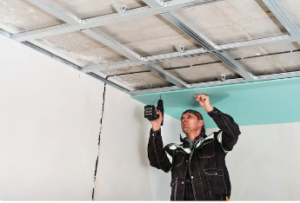Textured drywall repair after water damage is crucial because it helps restore the wall’s structural integrity and appearance. Water damage can weaken and compromise the integrity of drywall, leading to potential safety hazards and costly repairs if addressed. It can also create unsightly stains and mold growth, affecting the air quality in your home or building.
Textured Drywall Repair quickly and correctly can prevent further damage and help maintain your property’s value and aesthetics.
- Remove any damaged or wet drywall material, including any tape or compound that has come loose.
- Use a drywall saw to cut out a clean and even section of the damaged drywall.
- Measure and cut a new piece of drywall to fit the opening,
- Secure the new drywall with screws, making sure to screw it into the framing around the opening.
- Apply joint compound to the edges of the new drywall, and feather it out about 6-8 inches beyond the repair area.
- Allow the joint compound to dry completely, which typically takes about 24 hours.
- Sand the joint compound until it’s smooth and level with the surrounding wall.
- Apply a coat of primer to the repaired area to help the paint adhere properly.
- Once the primer is dry, apply a coat of paint that matches the existing wall color.
- To match the texture of the surrounding wall. Allow the texture to dry completely before applying a final coat of paint to blend the repair area with the surrounding wall.
A homeowner can do textured drywall repair after water damage by themselves, as long as they have the necessary tools and materials and are willing to put in the time and effort required.
Here are some professionals you can contact:
- Drywall repair specialist: A drywall repair specialist has expertise in all aspects of drywall repair, including patching and texturing. They have the tools and knowledge necessary to complete the repair quickly and efficiently.
- Water damage restoration company: A water damage restoration company can handle the entire restoration process, from removing water and drying out the affected area to repairing drywall and other structural components.
- General contractor: handle all aspects of the repair, including coordinating with other trades and ensuring that the repair is done to code.
Considering working with to ensure that they are licensed, insured, and have a good reputation in the community.



